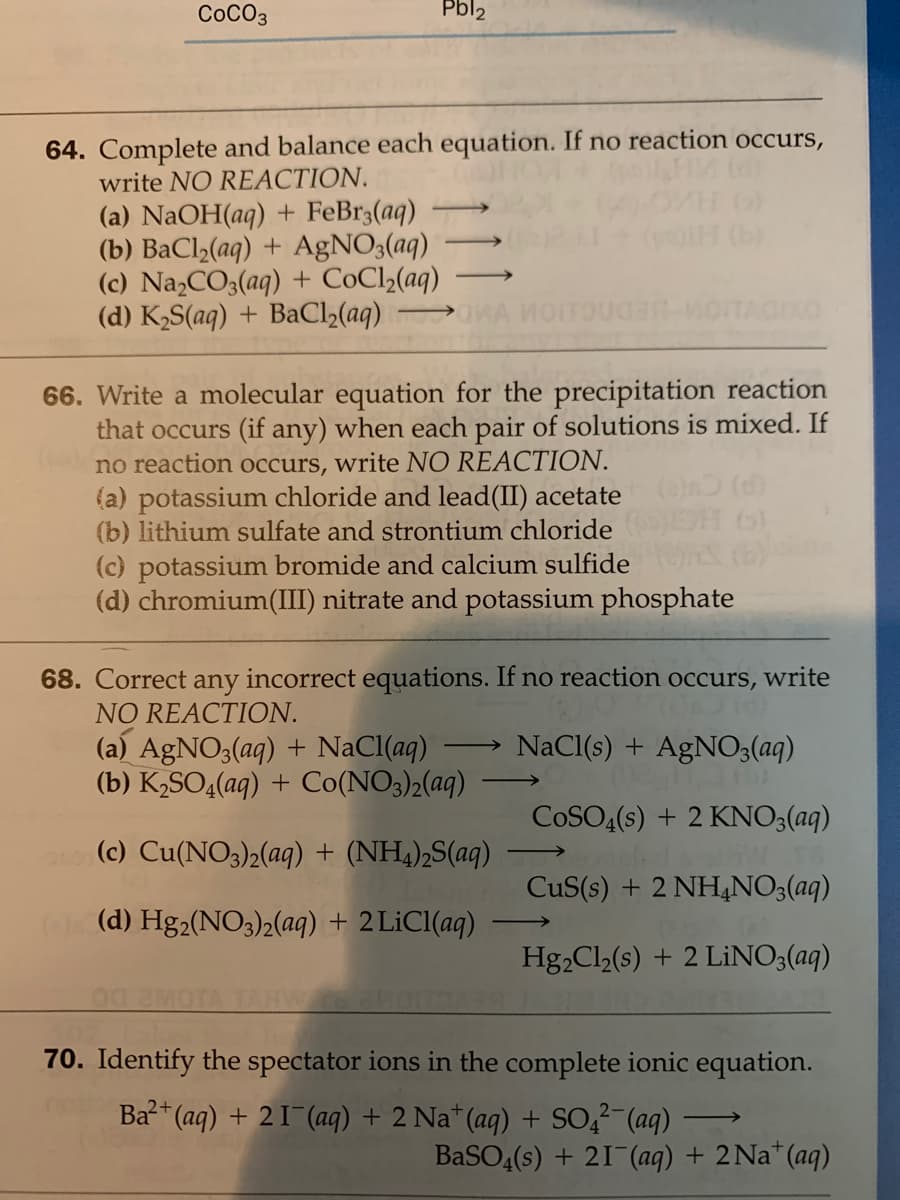Write a molecular equation for the precipitation reaction that occurs (if any) when each pair of solutions is mixed. If no reaction occurs, write NO REACTION. (a) potassium chloride and lead(II) acetate (b) lithium sulfate and strontium chloride (d) (c) potassium bromide and calcium sulfide (b) (d) chromium(III) nitrate and potassium phosphate
Write a molecular equation for the precipitation reaction that occurs (if any) when each pair of solutions is mixed. If no reaction occurs, write NO REACTION. (a) potassium chloride and lead(II) acetate (b) lithium sulfate and strontium chloride (d) (c) potassium bromide and calcium sulfide (b) (d) chromium(III) nitrate and potassium phosphate
Chemistry: Principles and Practice
3rd Edition
ISBN:9780534420123
Author:Daniel L. Reger, Scott R. Goode, David W. Ball, Edward Mercer
Publisher:Daniel L. Reger, Scott R. Goode, David W. Ball, Edward Mercer
Chapter14: Chemical Equilibrium
Section: Chapter Questions
Problem 14.74QE: Lead poisoning has been a hazard for centuries. Some scholars believe that the decline of the Roman...
Related questions
Question
66

Transcribed Image Text:СосОз
Pbl2
64. Complete and balance each equation. If no reaction occurs,
write NO REACTION.
(a) NaOH(aq) + FeBr3(aq)
(b) BaCl2(aq) + AgNO3(aq)
(c) Na,CO3(aq) + CoCl2(aq)
(d) K½S(aq) + BaCl2(aq)
H (b)
66. Write a molecular equation for the precipitation reaction
that occurs (if any) when each pair of solutions is mixed. If
no reaction occurs, write NO REACTION.
(a) potassium chloride and lead(II) acetate
(b) lithium sulfate and strontium chloride
(e) (d)
(6)
(c) potassium bromide and calcium sulfide
(d) chromium(III) nitrate and potassium phosphate
68. Correct any incorrect equations. If no reaction occurs, write
NO REACTION.
(a) AgNO3(aq) + NaCl(aq)
(b) K,SO4(aq) + Co(NO3)2(aq)
NaCl(s) + AgNO3(aq)
COSO,(s) + 2 KNO3(aq)
(c) Cu(NO3)2(aq) + (NH4),S(aq)
CuS(s) + 2 NH,NO3(aq)
(d) Hg2(NO3)2(aq) + 2 LİCI(aq)
Hg,Cl(s) + 2 LiNO3(aq)
70. Identify the spectator ions in the complete ionic equation.
Ba* (aq) + 21 (aq) + 2 Na*(aq) + SO,² (aq)
>
BaSO4(s) + 21 (aq) + 2 Na*(aq)
Expert Solution
This question has been solved!
Explore an expertly crafted, step-by-step solution for a thorough understanding of key concepts.
This is a popular solution!
Trending now
This is a popular solution!
Step by step
Solved in 2 steps with 4 images

Knowledge Booster
Learn more about
Need a deep-dive on the concept behind this application? Look no further. Learn more about this topic, chemistry and related others by exploring similar questions and additional content below.Recommended textbooks for you

Chemistry: Principles and Practice
Chemistry
ISBN:
9780534420123
Author:
Daniel L. Reger, Scott R. Goode, David W. Ball, Edward Mercer
Publisher:
Cengage Learning

Chemistry: Principles and Practice
Chemistry
ISBN:
9780534420123
Author:
Daniel L. Reger, Scott R. Goode, David W. Ball, Edward Mercer
Publisher:
Cengage Learning